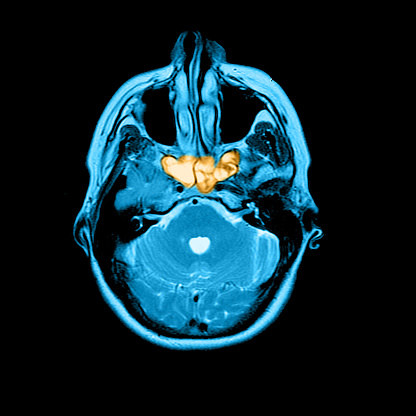 |
| Advertisement |
It started with a cold, then progressed to severe headaches and other symptoms that prompted several trips to the emergency room.
Marquel Brumley, a 13-year-old from Mount Morris, Michigan, died last week after a bacterial sinus infection spread to his brain.

Marquel first showed signs of a cold in mid-February. "He came down with a typical cold, he had a stuffy nose and sore throat, so his mom took him to urgent care, but they said it was a virus that would go away on its own and sent him home without medication," his aunt, Nicole Alexander, told BuzzFeed News.
The cold symptoms did go away, for the most part, with the exception of some sniffling. But then the headaches began.
Photo Courtesy of Nicole Alexander
In the following weeks, Marquel's severe headache sent him to the ER twice.

The first time, doctors diagnosed him with a migraine and gave him over-the-counter pain meds. "They said it could be migraines or stress headaches so we should just watch it and continue [with] the Tylenol and Motrin," Alexander said.
While the over-the-counter pain meds would help Marquel's symptoms for a few hours, the piercing headaches still kept coming back. So a week later, Marquel was back in the ER. This time, Alexander said doctors gave Marquel a "migraine cocktail," which consisted of an antihistamine (Benadryl) and more painkilling medications (Tylenol, Advil).
"He felt so bad that he wasn't eating or drinking well, so they gave him fluids thinking that could help the headaches, and the migraine cocktail with Benadryl to help him sleep," Alexander said.
Marquel felt a little better, Alexander said, and stayed with his aunt for the weekend while continuing the over-the-counter pain meds. "Nobody was thinking it was anything other than what they told us it was [a migraine]," Alexander said.
Meshaphoto / Getty Images / Via gettyimages.com
Then Marquel woke up with a swollen eye and had trouble moving one side of his face. He was rushed to the ER, where doctors found a sinus infection had spread to his brain.

When Marquel arrived at the hospital, doctors did an MRI that revealed that a bacterial sinus infection had spread, causing blood clots that triggered strokes.
"The blood clot behind his eye was causing the swelling, and there was pus in between his skull and his brain. ... We later learned that he had already had strokes, which was why his face was drooping," Alexander said. Marquel was given intravenous antibiotics and taken by ambulance to C.S. Mott Children's Hospital in Ann Arbor, Michigan.
Photo Courtesy of Nicole Alexander
Doctors performed surgery to control the infection, but the blood clots and increased pressure had cut off oxygen to his brain. He died a few days later.

Once he arrived at the hospital in Ann Arbor, doctors decided they needed to perform surgery to control the infection.
"A neurosurgeon went in and removed the infection and pus from around the brain and skull and an ENT came and removed whatever infection he could from the sinus cavity," Alexander said. (An ENT is an ear, nose, and throat doctor.) Although doctors were able to remove much of the infection, the blood clots had already put too much pressure on his brain.
"They continued a regimen of antibiotics and blood thinners to dissolve the blood clots, but they didn't dissolve quickly enough. ... Between the infection and blood clots there was so much swelling and pressure in the brain that it cut off oxygen and caused the brain to die," Alexander said. Marquel Brumley was pronounced dead on Sunday, March 11.
Marquel was remembered by his family and community as incredibly kind, bright, and helpful. "He was a straight-A student, played football and played the trumpet. ... His goal every day was to make people smile and everyone loved him," Alexander said.
Photo Courtesy of Nicole Alexander
"The biggest problem with diagnosing sinus infections (sinusitis) is that they don't always have very distinctive symptoms, and it can be hard to tell if you're dealing with a bacterial infection or a viral infection," Dr. Richard Lebowitz, professor in the Department of Otolaryngology at NYU Langone Health (who did not treat Marquel), told BuzzFeed News.
Viral and bacterial sinus infections often begin with the same symptoms: congestion, sinus drainage, pressure, pain, and low-grade fever. Although symptoms like green mucus or bad breath are sometimes thought to be signs of bacteria, that isn't always true. "A viral infection from a cold is still an infection so your mucus will probably be green or yellow instead of clear," Lebowitz said. If the infection is viral, antibiotics won't help — you just need rest, fluids, and over-the-counter pain meds when needed.
The most telling sign of a bacterial infection is the timeframe. "The cold will run its course, so a week to 10 days, and then you'll have persistent symptoms or localized pain in the sinuses or cheeks," Lebowitz said. So if your symptoms do not improve or go away after about a week, seek medical care.
Doctors often diagnose sinusitis by looking at the progression of the symptoms and patient history. "The only way to really confirm a bacterial sinus infection is in an ENT office, where we put an endoscope in the nose and we can see where the sinus is draining into the nose," Lebowitz said.
It is very rare for a sinus infection to spread to the brain, but antibiotics can usually help prevent these complications. If you are worried about sinusitis, see a doctor.

"The most common complication in children is for the sinus infection to spread to the orbital region, so the kid will have redness or swelling around their eye," Lebowitz said. If the infection continues to spread, it can cause a blood clot in the veins behind the eyes and spread to the sinuses between the brain and skull. It's called cavernous sinus thrombosis, according to Lebowitz, and this can lead to strokes, encephalitis, a brain abscess, and death.
However, it is very rare for this to happen, and there are typically many warning signs. "Usually, the first signs involve the eyes and it takes a while to move to the brain, but sometimes you can just have a severe headache, which might just seem like a migraine," Lebowitz said. In either case, antibiotics are needed to help treat the infection before it spreads and becomes more dangerous.
If you are worried that you or your child has a bacterial sinus infection, see an ear, nose, and throat doctor (ENT), pediatrician, or primary care doctor to get a proper diagnosis. While rare, Marquel's case highlights the importance of watching for warning signs and symptoms.
Medical Body Scans / Getty Images / Via gettyimages.com
After he died, Marquel was an organ donor. "It gives us a little comfort because he just wanted to help people and he still is helping even though he's not here," his aunt said.

"We just want to move on and heal from this, and we are telling his story to raise awareness. ... Listen to the signs and symptoms and even if you are not sure, just go to the doctor to have them check you," Alexander said.
After Marquel's death, his family donated his organs to seven people. "It's bittersweet. Obviously, that human part of us would rather have him here with us, but at least out of our loss, seven people don't have to go through what he went through," Alexander said.
The family started a GoFundMe to raise money for Marquel's funeral expenses and his mother's lost wages.


0 comments: